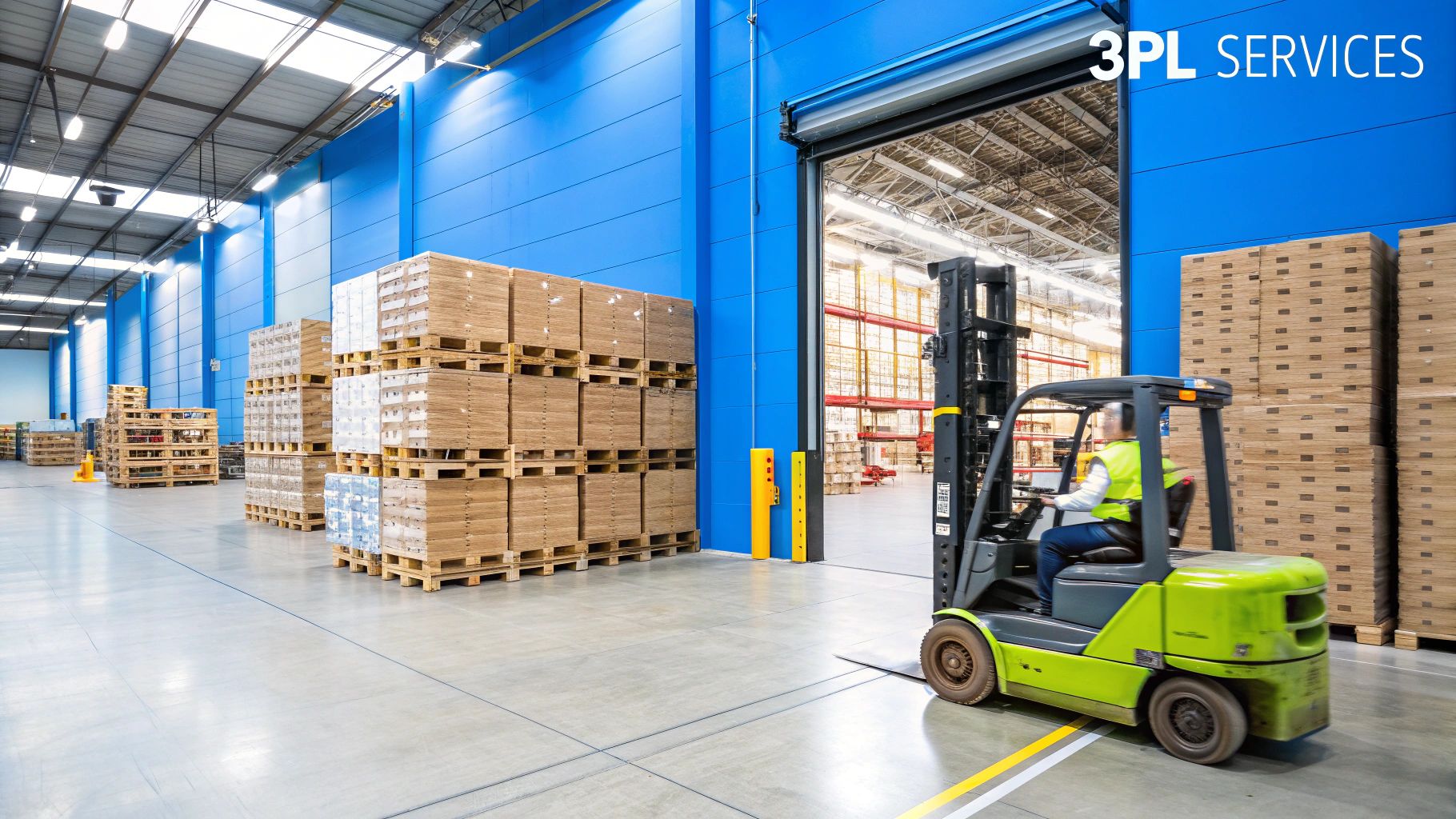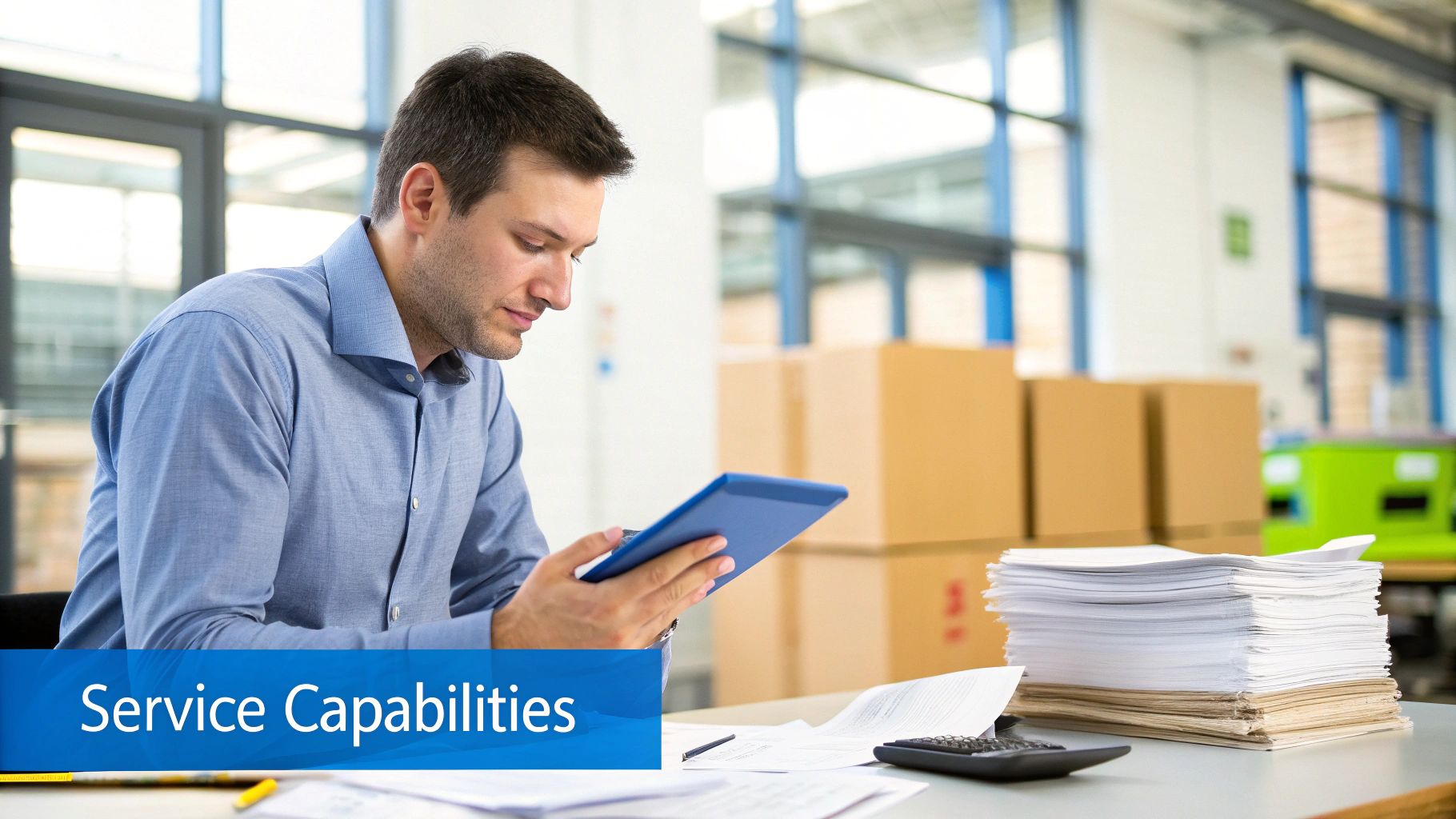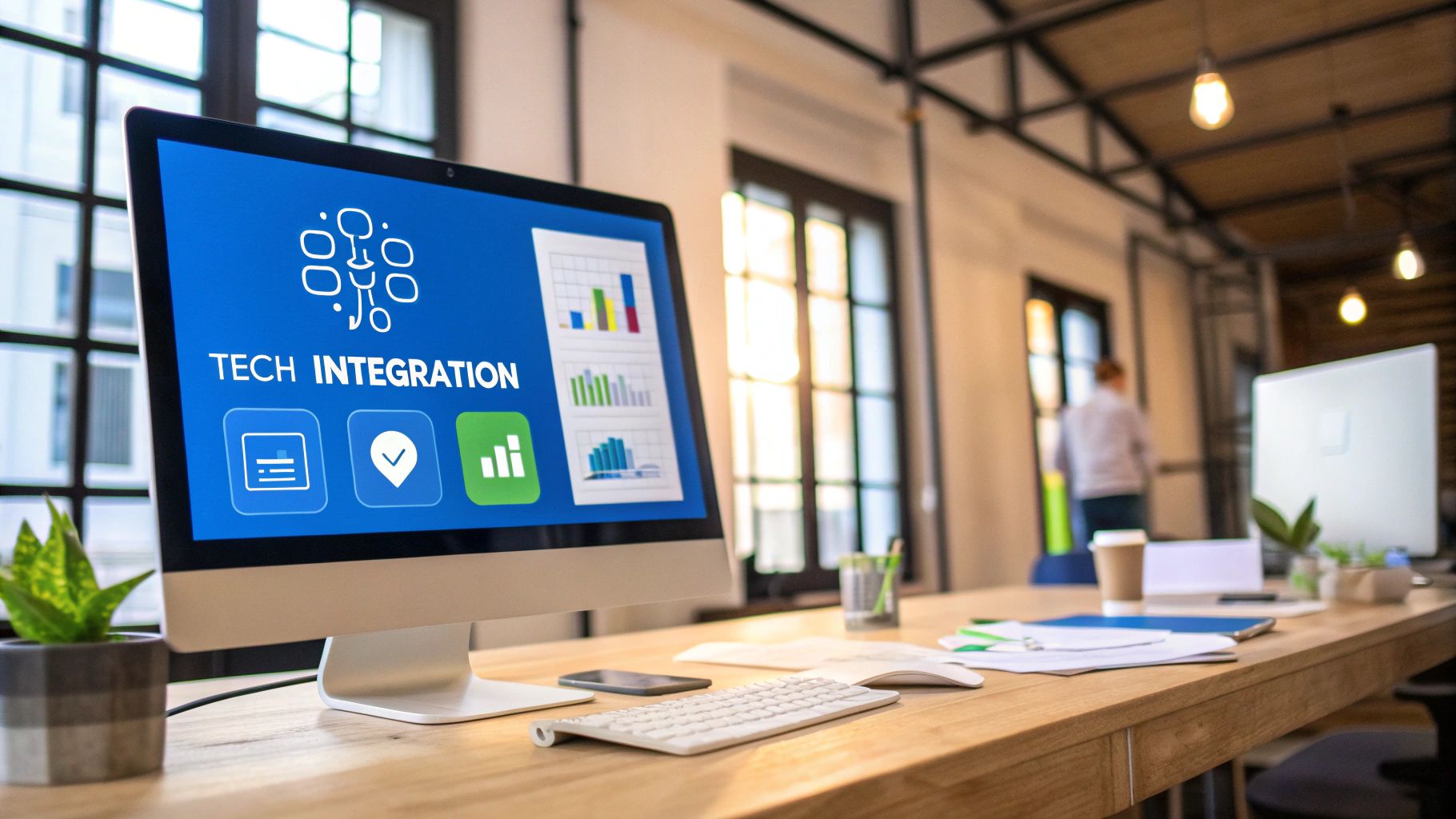Picking the right 3PL is less about finding a vendor and more about finding a true partner—one that lines up perfectly with your business needs, your tech stack, and your growth ambitions. The whole process really comes down to a few key things: a deep, honest look at what you actually need, a tough evaluation of what they can do, a forward-looking assessment of their technology, and—this is a big one—finding a team that you genuinely click with.

Let’s be clear: choosing a third-party logistics (3PL) provider is way more than just outsourcing your shipping. It’s one of the biggest strategic moves an e-commerce brand can make. This decision directly impacts your customer satisfaction, how stable your operations are, and your fundamental ability to scale. You have to stop thinking of a 3PL as a vendor and start seeing them as an extension of your own team.
A great partner becomes your growth engine. Seriously. They take on the messy, time-consuming work of storing, picking, packing, and shipping. This frees you up to pour your energy into what you do best: developing amazing products, marketing like a pro, and building relationships with your customers. The right provider delivers a seamless experience that reinforces your brand’s promise with every single package that lands on a doorstep.
On the flip side, a bad partnership can quickly become an anchor dragging your business down. We're talking lost inventory, infuriatingly delayed shipments, and surprise fees that bleed your budget dry. Your logistics can turn into a constant source of headaches instead of the competitive advantage it should be. This is exactly why a methodical, well-thought-out approach to choosing a 3PL is non-negotiable for any brand that’s serious about growth.
The global 3PL market is absolutely booming, thanks to the non-stop growth of e-commerce. In 2024, it was valued at a staggering USD 1.19 trillion and is on track to more than double to USD 2.57 trillion by 2034. That explosive growth means you have more options than ever, which makes having a structured evaluation framework even more critical. You can get more insights on this trend from market analysts like Infocastinc.
Before you even think about requesting quotes, a successful selection process has to be built on four core pillars. You need to look inward first, then outward with a clear game plan.
To keep it simple, here’s a breakdown of the essential areas to focus on when you're evaluating potential partners.
Focusing on these key areas helps you see beyond a simple price sheet. You start to evaluate providers based on their real potential to be a long-term growth partner who will help you scale.
The goal isn't just to find a company that can ship boxes. The real goal is to find a partner who gets your vision and has the infrastructure, technology, and expertise to help you get there, especially as you scale your e-commerce fulfillment operations.
By laying this groundwork, you set yourself up to make a strategic decision that will pay off for years to come, turning your logistics from a cost center into a powerful driver of growth.
Before you even think about looking at 3PL websites or booking a demo, you have to do some serious internal homework. Jumping into the selection process without a crystal-clear picture of your own business is like trying to build a house with no blueprint. You need to first map out your company’s unique “logistics fingerprint”—a detailed self-assessment that becomes the foundation for your entire search.
This isn’t just about knowing your average order count. It’s about digging into the specific DNA of your fulfillment operations. Start with the hard numbers. What's your average monthly order volume, and more importantly, what does that number look like during your peak season? A 3PL that handles 1,000 orders a month with ease might completely crumble under the pressure of 10,000 orders during the Black Friday rush.
Next up is your product catalog. How many unique SKUs (Stock Keeping Units) are you actually managing? A business with 10 core products has vastly different storage and picking needs than an apparel brand juggling 500 different sizes and colors.
From there, you have to define any special requirements your products demand. These are often the non-negotiables that will quickly filter your list of potential partners.
This process visualization breaks down how to move from looking at your own data to comparing potential partners.

The key takeaway here is that understanding your volume and service needs has to happen before you start comparing costs. It’s the only way to make a truly informed decision.
Where your customers live is just as important as what they buy. Pull a report of your order destinations from the past year. Is your customer base clustered on the West Coast, spread evenly across the country, or concentrated in the Midwest? Picking a 3PL with a warehouse strategically located near your customers can dramatically slash shipping costs and delivery times.
For many brands, this geographical analysis is a pivotal part of the decision. You can explore more about why you should consider a 3PL for your e-commerce fulfillment in our detailed guide.
Finally, you need to set a realistic budget. This goes way beyond a simple cost-per-order figure. Your budget needs to account for all the different fees involved:
Deciding how to choose a 3PL involves a deep analysis of both operational capabilities and your business goals. With nearly 73,000 third-party logistics businesses in the U.S., a detailed blueprint is the only way to navigate this fragmented market.
Once you have this logistics fingerprint in hand, you're no longer just window shopping. You can engage with potential partners from a position of strength, armed with the precise data they need to give you an accurate and meaningful proposal.

Once you’ve mapped out your logistics needs, it’s time to start the search for a partner. But this is where many brands make a critical mistake. They assume "fulfillment" is a generic, one-size-fits-all service.
The reality is that not all 3PLs are created equal. A provider that’s fantastic at shipping heavy-duty electronics might be a disaster for high-end apparel or health supplements. The biggest misstep you can make when learning how to choose a 3PL is underestimating the importance of niche expertise. A provider’s real value comes from their deep experience in your world.
Think about it. A direct-to-consumer (DTC) brand selling health supplements has completely different needs than a monthly subscription box company. The supplement brand requires meticulous lot tracking and expiration date management, while the subscription box service needs sophisticated kitting and assembly to build custom bundles.
A generalist provider trying to do both will inevitably cut corners. You need a partner whose entire operation is already built to handle the specific challenges your products present.
Here’s what that specialized fulfillment looks like in practice:
Signing with a generalist 3PL for a specialized product is asking for trouble. You’ll spend all your time teaching them the basics of your industry instead of them bringing new efficiencies to your business.
Of course, every 3PL's website will claim they can handle your products. Your job is to be a detective and verify those claims.
Start with their case studies. Are they just fluffy success stories, or do they contain specific, hard data relevant to your business? You want to see metrics on improved order accuracy, reduced shipping times, or cost savings for a brand that looks and feels like yours.
Next, get on the phone and talk to their current clients. Don’t settle for a simple, "Are you happy with them?" Ask pointed, operational questions that get to the heart of the matter:
The answers you get from these calls are worth more than any sales pitch. A truly experienced 3PL will have a roster of happy clients in your niche who can speak to their specific skills and problem-solving abilities.
This deep vetting process ensures you find a partner whose expertise is a perfect match for your business needs. They become a true asset that fuels your growth, not an operational headache that holds you back.
Let's talk about technology. In e-commerce, a 3PL’s tech isn’t just a nice-to-have feature—it’s the central nervous system of your entire fulfillment operation. I've seen brands get lured in by a low price, only to find themselves drowning in manual data entry, inventory nightmares, and shipping delays because the 3PL's tech was a decade old.
Getting this part right is absolutely critical when you're figuring out how to choose a 3PL that can actually keep up with your business.
The heart of their operation is the Warehouse Management System (WMS). This is the software they use to track every single item, manage orders, and run their facility. Your access to this system is your window into your own logistics. Without it, you’re flying blind.
This has become non-negotiable as e-commerce continues to explode. By 2025, it’s expected that nearly 70% of all third-party logistics services will be directly tied to e-commerce. That trend is forcing the logistics world to get serious about technology. If a potential partner isn’t tech-forward, they’re already falling behind. You can read up on more logistics statistics to see just how fast this space is moving.
A modern WMS shouldn't feel like you need a Ph.D. to use it. It should be intuitive and give you direct control over your fulfillment. When you're sitting through a demo, don't just let them click around a slick-looking dashboard. Ask them to hand you the controls. See for yourself how you would handle everyday tasks.
Here's a checklist of non-negotiables your potential partner's WMS must have:
Here’s a glimpse of what a WMS dashboard typically looks like. It’s designed to give you a quick, visual summary of your operations.
This kind of visual overview is what you should expect, letting you see key stats like order status and inventory levels at a glance.
A pretty dashboard is one thing, but you need to dig deeper into their tech infrastructure. Don’t be afraid to ask the tough questions—the ones about what happens when things go wrong.
A great 3PL invests in technology not just for their own efficiency, but for your peace of mind. Their tech stack should empower you with data and automate tedious tasks, freeing you to focus on growing your brand.
Probe them on their API capabilities. A flexible, well-documented API is crucial if you ever need to connect other business tools, like your ERP or a specialized marketing platform.
Also, ask directly about their system uptime guarantees and data security. What happens if their system goes down during Black Friday? How is your customer and order data protected? A provider who can clearly explain their tech roadmap is a partner planning for the future—and you want a partner who plans to grow with you.

When you start comparing quotes from different 3PLs, you’ll quickly notice something—the pricing sheets can be a total mess. It's confusing, and frankly, some providers seem to like it that way. They use complex fee structures that make a true apples-to-apples comparison almost impossible.
What often happens is the price that looks lowest at first glance ends up exploding with hidden charges on your first real invoice. Your best defense is knowing exactly what to look for. The entire process of how to choose a 3PL really boils down to your ability to see through the noise and understand the true, all-in cost of a partnership.
Let's break down the common charges and, more importantly, the "gotcha" fees you need to be on the lookout for.
Pretty much every 3PL will charge you for the same core activities. Your job is to dig into how they calculate each one. Don't just accept a line item like "Storage Fee"; you need to ask how it's calculated.
Here are the main costs you'll find on almost every quote:
Getting a handle on these basics is just the first step. The real work is hunting for the sneaky costs that can completely derail your budget. Our full guide on demystifying 3PL pricing and fulfillment costs takes a much deeper dive into these standard charges.
Pro Tip: I can't stress this enough—never, ever assume a quote is all-inclusive. If you don't see a specific fee on the pricing sheet, ask about it directly. A transparent partner will happily walk you through every potential charge. If they get evasive, that's a major red flag.
This is where your diligence really pays off. From my experience, many 3PLs build their profit margins on all the little extra fees they hope you won’t notice until you're locked into a contract. As you review a quote, put on your detective hat and be on high alert for these common culprits.
Common Hidden 3PL Fees
By asking direct, pointed questions about these potential fees, you force them to be transparent. This simple step helps you build a realistic cost projection and, ultimately, choose a partner whose pricing is as straightforward as their operations.
As you get closer to choosing a 3PL, the big-picture strategic questions often give way to smaller, more practical ones. We’ve been helping brands navigate this exact point in their journey for years, so we've heard just about every question you can imagine.
Getting clear, honest answers to these common sticking points is the final step in feeling truly confident about your decision. Think of this as your cheat sheet for those last-minute "what about...?" moments.
Honestly, the tipping point isn't about hitting a specific number of daily orders. It’s more of a feeling—that nagging sense that you're spending hours taping boxes when you should be crafting your next marketing campaign. It's when your garage is overflowing, your office looks more like a warehouse, and you're starting to see customer complaints about shipping errors.
The real signal is when logistics stops being a background task and starts becoming your main job. If you feel like you’re running a shipping company instead of building your brand, it's time to start looking for a partner.
This is one of the biggest—and most important—strategic questions you’ll face. The answer is almost always the same: choose a 3PL located centrally to your customers, not to you.
Unless your customer base is hyper-concentrated in your city, placing your inventory closer to where your buyers live is a game-changer. This simple move dramatically cuts down on shipping costs and speeds up transit times by getting packages into lower, cheaper shipping zones (like Zones 1-4). A local 3PL only makes sense in very rare cases; for the vast majority of e-commerce brands, customer proximity is king.
For a deeper dive into this, our e-commerce guide to 3PL services breaks down exactly how warehouse location impacts your bottom line.
When you're vetting a potential partner, you have to keep your eyes open for warning signs. From our experience, a few major red flags should give you immediate pause:
Onboarding time can vary quite a bit, and it all comes down to complexity. For a straightforward e-commerce store with a handful of SKUs and a simple Shopify integration, you could be up and running in as little as 2-4 weeks.
On the other hand, if your business has more complex needs—like custom kitting, multiple sales channels, or a tricky ERP integration—you should plan for a longer timeline, often in the 8-12 week range. Don't be afraid to ask for a detailed, week-by-week onboarding plan from any provider you're seriously considering.
At Simpl Fulfillment, we believe logistics should accelerate your growth, not complicate it. Our transparent pricing, seamless tech integrations, and dedicated support team are designed to make your fulfillment effortless. Get a quote from Simpl Fulfillment today and discover how a true partnership can transform your business.